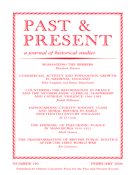-
Views
-
Cite
Cite
Mark Gamsa, The Epidemic of Pneumonic Plague in Manchuria 1910–1911, Past & Present, Volume 190, Issue 1, February 2006, Pages 147–183, https://doi.org/10.1093/pastj/gtj001
Close - Share Icon Share
Extract
Of the three forms of plague known to affect man, the most common bubonic variety (taking its name from the swollen ‘buboes’ that develop on the patient’s body) is carried by fleas from rodents to humans, but does not otherwise pass from person to person; before these facts were established by bacteriological science and before the emergence of antibiotics, this plague, most famously associated with the fourteenth-century Black Death, proved lethal for about 60 per cent of its victims. Swift to spread through an infected organism, and potentially fatal even with modern medical intervention, septicaemic plague (in which bacteria penetrate the blood system) would count as the most dangerous form were it to constitute an epidemic in itself, rather than a complication liable to accompany the bubonic or the pneumonic kind. That last, an extreme type of lung infection, highly contagious and still impossible to cure unless identified within the first twenty-four hours, is the rarest as well as the deadliest form of a plague epidemic. The Manchurian outbreak in the autumn of 1910 was the worst such epidemic in recorded history.




